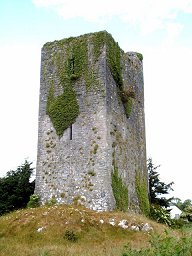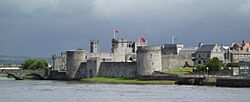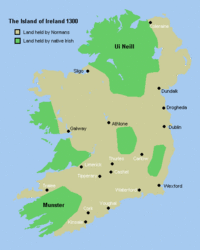History of Ireland (1169–1536) facts for kids


The history of Ireland from 1169 to 1536 tells the story of a big change. This period started when Norman knights arrived in Ireland. Before this, Irish kingdoms often fought each other for control of the island. The Normans, who had already conquered England, stepped into these fights.
After the Norman invasion in 1169–1171, the King of England gained some control over Ireland. Much of the land was taken by Norman lords. Over time, the area directly controlled by the Normans in Ireland, called the the Pale, became smaller. It stretched from Dublin to Dundalk. Norman lords living outside this area started to adopt Irish customs and language. They became known as the Hiberno-Normans or "Old English."
Contents
Normans Arrive in Ireland (1167–1185)
By the 1100s, Ireland was divided into several large kingdoms. The rulers of these kingdoms often fought to become the High King of Ireland, who was meant to rule the whole island.
One of these rulers was Dermot MacMurrough, the King of Leinster. In 1167, he was forced out of his kingdom by other Irish forces led by the new High King, Ruaidrí Ua Conchobair.
MacMurrough went to England and asked for help from King Henry II. Henry II allowed his subjects to help MacMurrough. MacMurrough then got help from Norman knights, especially a powerful leader named Richard de Clare, 2nd Earl of Pembroke, also known as Strongbow.
The first Norman knight arrived in Ireland in 1167. But the main Norman forces, along with their Welsh and Flemish fighters, landed in Wexford in 1169. Soon, MacMurrough got his kingdom of Leinster back. He also took control of Waterford and Dublin. Strongbow married MacMurrough's daughter, Aoife, and was named heir to Leinster. This worried King Henry II, who didn't want a powerful Norman state in Ireland that he couldn't control. So, he decided to go to Ireland himself.
King Henry II's Visit to Ireland
In 1155, Pope Adrian IV, who was English, had given Henry II permission to invade Ireland. The Pope wanted to fix some problems in the Irish Church. This permission was given in a special letter called a Papal Bull named Laudabiliter.
In 1171, King Henry II landed in Waterford with a large army. He was the first King of England to visit Ireland. He declared Waterford and Dublin to be Royal Cities. Henry gave his new lands in Ireland to his youngest son, John, calling him the "Lord of Ireland." Later, when John became King John of England, the "Lordship of Ireland" became directly controlled by the English Crown.
Many Irish kings welcomed Henry. They hoped he would stop the Normans from expanding too much. In 1175, Henry and Ruaidhrí, the Irish High King, signed the Treaty of Windsor (1175). But after MacMurrough and Strongbow died, and Henry went back to England, the treaty didn't last. Norman lords continued to take more land. For example, John de Courcy took much of eastern Ulster in 1177.
How the Norman Invasion Changed Ireland
The Norman invasion brought many lasting changes to Ireland. Instead of just ruling people, the Normans started to settle the land. They built walled towns, many castles, and churches. They brought new farmers and increased farming and trade.
The Normans also introduced feudalism, a system where land was given in exchange for loyalty and service. This was different from the Irish system of sharing crops. Many Irish people today have Norman-sounding last names like Burke, Roche, and Power.
The system of counties was introduced in 1297. Towns also became very important. Dublin, for example, received a special charter in 1192 to encourage trade and give more rights to townspeople.
The Church also changed. It focused on parishes and dioceses instead of just abbeys. Hundreds of new churches were built. The Normans also brought their own legal system, which included prisons for criminals. The traditional Irish law, called "Brehon Law," continued in areas not controlled by the Normans.
The Lordship of Ireland (1171–1300)

At first, the Normans controlled large parts of Ireland. They held the entire east coast, from Waterford up to eastern Ulster, and even reached as far west as Galway and Mayo. Powerful Norman families, like the Geraldines, Butlers, and de Burghs, controlled huge areas. These areas were almost independent from the English government in Dublin or London.
King John, who was the Lord of Ireland, visited in 1185 and 1210. He helped make the Norman areas stronger and made sure many Irish kings promised loyalty to him. Many Irish kings, like Cathal Crobhdearg Ua Conchobair, even owed their thrones to King John and his armies.
The Normans had strong leaders. Also, after England lost Normandy in 1204, King John could focus more on Irish matters, even from far away.
Norman Power Starts to Decline (1300–1350)
The Norman rule in Ireland reached its peak with the creation of the Parliament of Ireland in 1297. But then, a series of events in the 1300s stopped the Normans from spreading their power further.
First, Irish lords launched many attacks against the English lordships. They changed their fighting style, using raids and surprise attacks instead of big battles. This made it harder for the Normans to hold their land, and Irish chieftains often won back territory.
Second, the English kings, Henry III and Edward I, were busy with problems in England and France. This meant the Norman settlers in Ireland didn't get much financial help from the English Crown. This limited their ability to keep control of their lands.
Third, the Normans themselves started fighting each other. This led to wars between powerful Norman families like the de Burghs, FitzGeralds, and Butlers. Also, when Norman estates were divided among heirs, they became smaller and weaker.
Four big events in the 14th century really shook the English presence in Ireland:
- In 1315, Edward Bruce of Scotland invaded Ireland. He gathered many Irish lords to fight against the English. Even though Bruce was eventually defeated, his troops caused a lot of damage, especially around Dublin. During this chaos, Irish lords won back much of the land they had lost.
- A terrible famine hit Europe, including Ireland, from 1315 to 1317. Irish ports couldn't get food, and Bruce's invasion also led to crops being burned.
- In 1333, William Donn de Burgh, 3rd Earl of Ulster was murdered. His lands were split, and his family in Connacht started a civil war against the English Crown. They became new Irish clans, and English power was lost in most of Ireland west of the River Shannon.
- The Black Death, a terrible plague, arrived in Ireland in 1348. It hit the English and Norman people much harder because they lived mostly in towns and villages. The native Irish, who lived in spread-out rural areas, were less affected. This plague was a disaster for the English settlements. After it passed, the Irish language and customs became dominant again. The English-controlled area shrank back to the Pale, a small fortified area around Dublin.
At the same time, the Hundred Years' War (1337–1453) between England and France meant that fewer soldiers and resources could be sent to protect the English Lordship in Ireland.
Irish Culture Returns (1350–1500)
Outside the Pale, many Norman lords started to adopt the Irish language and customs. They became known as the Old English, and people said they became "more Irish than the Irish themselves." In later centuries, they often sided with the native Irish against England.
The English government in Dublin was worried about this. In 1367, they passed special laws called the Statutes of Kilkenny. These laws tried to stop people of English descent from speaking Irish, wearing Irish clothes, or marrying Irish people. However, the government in Dublin didn't have much power, so these laws didn't really work.
Throughout the 1400s, the English government's power in Ireland kept getting weaker. The English monarchy was also busy with wars at home, like the Wars of the Roses (1460–85). Because of this, England didn't get involved much in Ireland. English kings gave their power over Ireland to the powerful Fitzgerald earls of Kildare. These earls controlled Ireland through military strength and alliances with Irish lords. This made the English Crown even more distant from what was happening in Ireland. At the same time, Irish and Gaelicised lords grew stronger, creating a way of life very different from English ways. This situation lasted until the Tudors started to reconquer Ireland.
See also
- The Deeds of the Normans in Ireland
- History of Ireland




